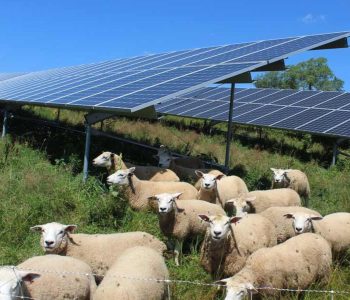Solar Sheep: The Untapped Goldmine Beneath Canada’s Solar Panels
While the classic image of shepherds herding sheep evokes tradition and simplicity, a new study from Western University reveals a modern twist that’s driving serious profits—not from herding, but from breeding and raising sheep for solar farms.
The research, published in Applied Energy and led by Dr. Joshua Pearce, professor at Western’s Faculty of Engineering and Ivey Business School, spotlights a booming opportunity in agrivoltaics—the dual use of land for agriculture and solar energy. Specifically, it finds that raising “solar sheep”—animals used to graze vegetation beneath solar panels—is not only sustainable but highly profitable.
“Agrivoltaic sheep are a simple and easy solution for the co-existence of agriculture and solar energy on Canadian farms,” said Pearce, who also holds the John M. Thompson Chair in Innovation.
“The sheep like the shade, plus the solar panels increase grass yield and protect sheep from predators. Conversely, sheep eliminate the need for herbicides or expensive mowing. And shepherds get a reliable income. Everyone wins.”
A Strategic Partnership: Sheep and Solar Farms
This model is already being implemented with success at The Lara Costa farm in Vittoria, Ontario. Run by professional shepherd Rafael Lara and his wife Gabriella, the farm manages vegetation naturally across nearly 2,000 acres using over 3,000 sheep. A director of Ontario Sheep Farmers and an animal science graduate from Universidade de São Paulo, Lara calls this approach “one of the most fantastic alternatives” for advancing both clean energy and animal agriculture.
“The soil’s productive potential is higher than that of a regular pasture in the same area,” said Lara. “Partial shading from panels retains moisture and boosts resilience against extreme weather.”
In fact, solar farms maintained with sheep grazing:
- Outperform traditional pastures
- Offer natural shade and protection for animals
- Make 100% of the land grazable
- Come equipped with fencing and security infrastructure that doubles as farm protection
The Lara Costa model showcases how sheep can graze even the most difficult terrain, reducing labor costs and ecological footprint, as supported by a 2022 study from Pearce and Michigan Tech’s Robert Handler that found sheep to be the most eco-friendly way to manage vegetation on solar sites.
Canada’s Missed Opportunity in Agrivoltaics
Although Canada was an early North American adopter of sheep-based agrivoltaics, growth has stalled, and other countries—especially the United States—are pulling ahead.
“Texas tripled its sheep population thanks to agrivoltaics, while Canada has fallen behind,” Pearce noted.
At the same time, Canada imports over $250 million in lamb and mutton annually, a market gap that solar sheep could help close.
Big Returns for Modern Shepherds
The study doesn’t just highlight ecological benefits. It takes a hard look at the economics of integrating sheep into solar farm management—and the results are eye-opening.
Through a series of case studies, including both small family-run farms and industrial-scale solar operations, researchers found:
- Shepherds’ earnings (before tax, depreciation, etc.) consistently exceed agriculture industry norms
- Return on investment for breeding ewes ranged from 16% to 31%
- ROI for auction-purchased lamb models ranged from 22% to 43%
While the auction model offers quicker profits, breeding ewes generates stronger margins, highlighting trade-offs between up-front investment and long-term gains.
“This is the first study to rigorously evaluate the economics of sheep breeding for solar grazing, and the conclusion is clear—modern shepherds are thriving,” Pearce emphasized.
“There’s an enormous opportunity to keep millions in the country by using the grass under solar panels for lamb production.”
A Bright, Profitable Future Under the Panels
What began as a solution to a landscaping problem on solar farms is quickly becoming a sustainable agricultural innovation. The message from researchers is clear: solar sheep are not just a feel-good idea—they’re a financially sound strategy to energize Canadian agriculture and close a major import gap.
In the age of clean energy, the path to prosperity might just be paved with solar panels—and powered by sheep.
Source: myscience.ca
